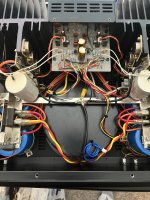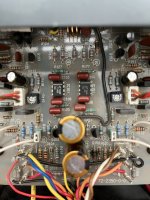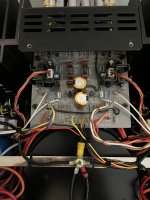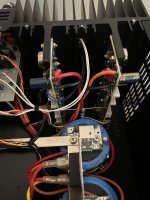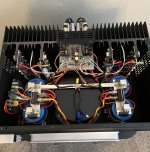Well I did it (buckled) - I placed a Mouser order and will have a new LT1006 for IC101 on Monday. To help me cope with $8 shipping, I'm going to replace the rest of the mica caps on the pre-amp board (2) and output boards (2), and found out the red Thermal Protection LED is burned out, so ordered replacements for the entire front panel, so they will match in color and intensity.
Also ordered some Panasonics FCs for the 470uF 25V supply caps on the pre-amp board - currently they are some "Audio Note - Kaisei" the previous owner installed. I found one place that sells them in the US and they market them as a slightly lower version of Black Gate caps. Seems like the wrong position in the circuit to use them, though, but I'll keep them and if the sound degrades with Panasonics I will put them back in.
After listening to the amp for 4-5 hours, I think it's worth getting it back in tip-top condition.
Also ordered some Panasonics FCs for the 470uF 25V supply caps on the pre-amp board - currently they are some "Audio Note - Kaisei" the previous owner installed. I found one place that sells them in the US and they market them as a slightly lower version of Black Gate caps. Seems like the wrong position in the circuit to use them, though, but I'll keep them and if the sound degrades with Panasonics I will put them back in.
After listening to the amp for 4-5 hours, I think it's worth getting it back in tip-top condition.
What I have found is leakage from the electrolytic capacitors making a conductive film. It is invisible, but stinks when you hit it with a soldering iron.
The fix? Depopulate the area and clean it carefully. I have used many cleaners, the stuff wants to stay. One amp I had to clean 5 or 6 times (I forget). The electrolytic caps have to go, and the semis need to be cleaned also. This stuff gets into the board and is hard on the copper.
There are other threads on this issue.
-Chris
The fix? Depopulate the area and clean it carefully. I have used many cleaners, the stuff wants to stay. One amp I had to clean 5 or 6 times (I forget). The electrolytic caps have to go, and the semis need to be cleaned also. This stuff gets into the board and is hard on the copper.
There are other threads on this issue.
-Chris
The ELNA leaking cap issue is for the GFA-565 and GFA-585 amplifiers. The GFA-555II is not prone to that problem and uses a different brand capacitors in it.
Yes, I am well aware of that. I have seen a similar issue in these.
I was Canadian warranty for Adcom.
I was Canadian warranty for Adcom.
Thanks for jumping in Chris, I have read a lot of threads and most of them say that the 555 is not as susceptible to electrolyte leakage, since they had different caps from the 565/585 models.
I will check again, but I touched up the solder joints on the pre-amp board, including the electrolytic caps and I didn’t notice any strange smells. Previous owner replaced all the electrolytic caps he said about 5 years ago, then sold because the right channel went out.
I will be replacing the remaining 2 electrolytic caps I haven’t touched when my order gets here on Monday, fingers crossed I don’t have an electrolyte issue. I didn’t notice any residue on the board, it was quite clean, compared to most amps I have worked on.
Keep you updated when I get some more parts.
I will check again, but I touched up the solder joints on the pre-amp board, including the electrolytic caps and I didn’t notice any strange smells. Previous owner replaced all the electrolytic caps he said about 5 years ago, then sold because the right channel went out.
I will be replacing the remaining 2 electrolytic caps I haven’t touched when my order gets here on Monday, fingers crossed I don’t have an electrolyte issue. I didn’t notice any residue on the board, it was quite clean, compared to most amps I have worked on.
Keep you updated when I get some more parts.
R129 (R179) 33k drops the +V rail voltage to a much lower level that the opamp can use and is clamped by D106 (D156) to approx 20 volts. C108 (C158) and C109 (C159) provide local DC bypassing.
Audio Note is supposed to be a premium product but overkill for a servo IC. John Curl said years ago that the Nichicon MUSE KZ were closest to Rubycon Black Gate quality.
Audio Note is supposed to be a premium product but overkill for a servo IC. John Curl said years ago that the Nichicon MUSE KZ were closest to Rubycon Black Gate quality.
Hi Chris,
Not to get into a peeing match, but my company was authorized ADCOM and Parasound until I retired 2 years ago. Never saw a GFA-555II with cap leakage and damaged board traces despite that being our most popular amplifier ever.
Not to get into a peeing match, but my company was authorized ADCOM and Parasound until I retired 2 years ago. Never saw a GFA-555II with cap leakage and damaged board traces despite that being our most popular amplifier ever.
Oops! Sorry this was a brain-fart, it should read "the output voltage from the DC servo can tell you how well balanced the amp is. I've corrected the website.
The 555 II servo has a single-sided power supply, because the correction signal is always positive, due to the fact that one of the transistors in the input long-tail pair runs at a higher current.
Turn-off noises like a click, a fart or bup-bup-bup sound are all normal on Adcoms, as mentioned above, the output remains connected while the capacitors drain. Turn-on noise should be a small pop, your woofer might pop out or in momentarily and quickly return to center.
Incidentally, the new GFA-555 SE has a relay on the outputs to prevent these noises, but they did not add any protection circuitry.
Normal range is 3 to 5V. Your servo op-amp seems to be op-amping just fine. You've got essentially 0V between inverting and non-inverting inputs, there is correct output from the servo, so as far as it's concerned, all is well.Low DC offset from the speaker terminals. This indicates good matching of the input transistors, and is generally a sign of good health. Incidentally, the GFA-555 MKII has a DC servo, so will show very low DC offset, even with poorly matched input transistors. In such an amp, the output current from the DC servo can tell you how well balanced the amp is.
The 555 II servo has a single-sided power supply, because the correction signal is always positive, due to the fact that one of the transistors in the input long-tail pair runs at a higher current.
Turn-off noises like a click, a fart or bup-bup-bup sound are all normal on Adcoms, as mentioned above, the output remains connected while the capacitors drain. Turn-on noise should be a small pop, your woofer might pop out or in momentarily and quickly return to center.
Incidentally, the new GFA-555 SE has a relay on the outputs to prevent these noises, but they did not add any protection circuitry.
Nope, I'm not in a peeing match at all. I have seen a few. I'm glad you haven't run into this. It is a real pain as you know from the other amps. I also get a steady diet of hacked amps. I haven't retired and I'm 64.
The list of high end brands I was authorized warranty for is long and well regarded. I was initially trained at Marantz in the old days. Factory warranty classification. Same for Carver and a few others. I also have a test and measurement background as well as telecom, certified on VoIP in 2004. I have a scary amount of experience, and more test equipment and of higher quality than you're likely to see in one place. I know a few others here that are similar.
I'm in the Toronto market, so I have seen huge amounts of stuff that have suffered all kinds of abuse. So maybe you haven't seen any examples of this. That's cool, and I am glad you haven't.
-Chris
The list of high end brands I was authorized warranty for is long and well regarded. I was initially trained at Marantz in the old days. Factory warranty classification. Same for Carver and a few others. I also have a test and measurement background as well as telecom, certified on VoIP in 2004. I have a scary amount of experience, and more test equipment and of higher quality than you're likely to see in one place. I know a few others here that are similar.
I'm in the Toronto market, so I have seen huge amounts of stuff that have suffered all kinds of abuse. So maybe you haven't seen any examples of this. That's cool, and I am glad you haven't.
-Chris
Yes Chris, you are correct.
I hated the input on these amps. Unbalanced by design and yes, the op amp was designed anticipating this. That circuit should have had a bipolar supply, but they saved a couple bucks by omitting it. It is guaranteed to make thumps. No relay doesn't help. Customers did complain.
The unbalanced diff pair doesn't help distortion performance either. So I couldn't see any positive reasons for that design. I have not bothered to try and build it normally. I bet you can do without the servo as well if the diff pair is just done properly. You know, by definition, a differential pair is supposed to run in a balanced state. The op amp tries to correct for that, and also beta mismatch. Personally I do not like DC servos, we didn't need them in the 1970's or 1980's, and to be honest we still do not. They only patch an unstable design. Poorly done they can affect the sound as well.
The op amp circuit. It uses an integrator (they all do), and because of that there is a time delay involved as it corrects the output DC offset. That's why you get a DC pulse that returns to a few mV. That circuit is designed in such a way that you will get turn-on thumps, period.
It wasn't the best sounding amplifier Adcom made.
I hated the input on these amps. Unbalanced by design and yes, the op amp was designed anticipating this. That circuit should have had a bipolar supply, but they saved a couple bucks by omitting it. It is guaranteed to make thumps. No relay doesn't help. Customers did complain.
The unbalanced diff pair doesn't help distortion performance either. So I couldn't see any positive reasons for that design. I have not bothered to try and build it normally. I bet you can do without the servo as well if the diff pair is just done properly. You know, by definition, a differential pair is supposed to run in a balanced state. The op amp tries to correct for that, and also beta mismatch. Personally I do not like DC servos, we didn't need them in the 1970's or 1980's, and to be honest we still do not. They only patch an unstable design. Poorly done they can affect the sound as well.
The op amp circuit. It uses an integrator (they all do), and because of that there is a time delay involved as it corrects the output DC offset. That's why you get a DC pulse that returns to a few mV. That circuit is designed in such a way that you will get turn-on thumps, period.
It wasn't the best sounding amplifier Adcom made.
This seems normal, I think you got it!DC offset progression:
Start-up = -4V (maybe 1/2 sec), Drops to ~50mV immediately (1-2secs later), Steady drop to ~20mV (30-45secs later) and finally drops to ~1mV (~10-12 mins from turn-on). All of these are lower, and drop faster with less fluctuation than it did before changing the input pair.
A couple things I recommend while you're in there... The to-126 transistors on these run pretty hot, and sometimes the solder joints crack from the stress. Re-flow the solder joints. You can attach small heatsinks to them and they won't ever be a problem. The heatsinks should be small and light so they don't stress the component leads. They only need a little more cooling.
The electrolytic supply bypass caps on the output modules are under a fair bit of stress. If you have the mini-marshmallow-sized 47/100V caps, they may be blown by now. Sometimes there are physically larger Panasonic 47/160V caps here and they're fine.
Check your bias-compensation cable headers and plugs for corrosion. When these go bad, the bias-spreader circuit goes haywire. Replace with any good 0.1" header/pin system. If you want to go fancy, Molex Nano-Fit, but it's tricky to solder the pins to the wires.
As Anatech mentioned, it is a good idea to clean the board. I haven't personally seen DC offset issues on a 555 II because of this, but the servo is fed by 4.7M resistors on its inputs, and its output goes through 1.5M. All high-impedance stuff, I can see how that could easily get skewed by old flux, or by dust that will eventually accumulate on flux residue.
That is what I meant by speaker protection circuitry. Delayed power on speaker connection with quick disconnect during power off to prevent thumps, pops, static, fizzling, farting, etc. I don't think that I said DC protection, only speaker isolation.Incidentally, the new GFA-555 SE has a relay on the outputs to prevent these noises, but they did not add any protection circuitry.
True, but if you have the relay and supply circuitry, adding protection really doesn't add cost.
There is zero excuse to not have effective speaker protection and some way to disconnect the speakers. At least Carver product very effectively protects speakers from fault currents. One of the only ones without disconnecting speakers that can say that.
There is zero excuse to not have effective speaker protection and some way to disconnect the speakers. At least Carver product very effectively protects speakers from fault currents. One of the only ones without disconnecting speakers that can say that.
I think the sound quality is quite good considering it has an excellent performance vs cost ratio. It is one of the top selling amplifiers ever. A few tweaks here and there will help.It wasn't the best sounding amplifier Adcom made.
Thanks guys @anatech @Phloodpants and @bigskyaudio you have all provided insight, guidance and specific parts to get this beast back in running order. At this point, I think I might keep this amp for a while, so fixing/replacing everything on both channels seems worth the effort and expense.
Here's some pics, two as it was originally and three showing it's current state.
Here's some pics, two as it was originally and three showing it's current state.
Attachments
"NAD is great for the money", yet it is crap and sounds bad.
I'm not picking on Adcom, they made better sounding amplifiers though. This one ain't the best.
I'm not picking on Adcom, they made better sounding amplifiers though. This one ain't the best.
Hi bullittstang,
Good!
If I owned that amplifier, I would fix it properly as well. Don't take my comments as negative please, it is a good amplifier.
-Chris.
Good!
If I owned that amplifier, I would fix it properly as well. Don't take my comments as negative please, it is a good amplifier.
-Chris.
What would you place as better and best from Adcom, or is the 555 lower than 3rd place in your ranking?I'm not picking on Adcom, they made better sounding amplifiers though. This one ain't the best.
I respect honest opinions if it's based on actual knowledge and experience. Can't stand someone that gives a strong opinion, but they haven't actually owned the equipment or listened to it for a decent amount of time before they formed their opinion. I find that I like certain amps for certain music and I like to switch them in and out of my system every month or two.
I currently have about a dozen amps (to my wife's dismay) - different brands, different classes and a few DIY designs, most well known and a couple more obscure. I build, repair and listen to each amp - only then do I decide if it's a keeper and if not I will sell it, or reuse the parts to build/repair something else. Always trying to learn a couple things with every build or repair.
I currently have about a dozen amps (to my wife's dismay) - different brands, different classes and a few DIY designs, most well known and a couple more obscure. I build, repair and listen to each amp - only then do I decide if it's a keeper and if not I will sell it, or reuse the parts to build/repair something else. Always trying to learn a couple things with every build or repair.
- Home
- Amplifiers
- Solid State
- Adcom GFA 555ii with high dc offset on one channel (V-)
